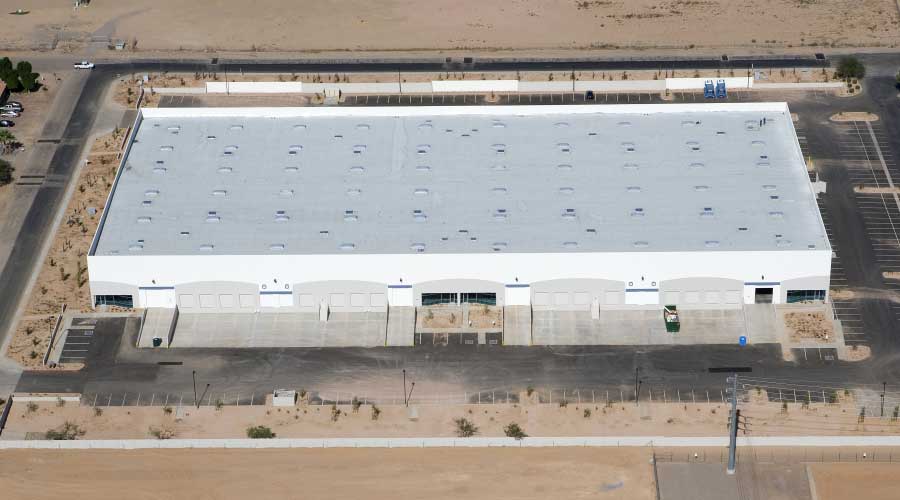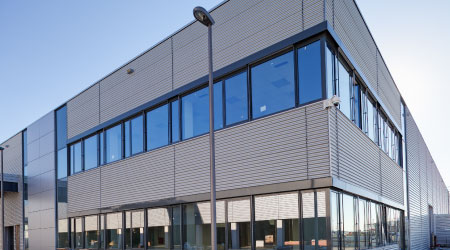Smart Overhead Management
Research and preparation before purchasing a roofing system pays long-term dividends
Roofing systems represent facilities’ first line of defense against water, an enormous threat to facility components and systems and their operations.
In specifying roofing systems for new construction and retrofit roofing projects, engineering and maintenance managers must juggle a number of competing and complementary issues. Among these considerations are first cost, life-cycle costs, materials, rooftop traffic, and post-installation maintenance demands.
Asphalt roofing systems have long been a popular choice for managers seeking a blend of long performance life and cost-effectiveness. As competing types of roofs have gained popularity, maintenance managers have revisited key elements of the their decision-making process, including advances in asphalt roofing, the benefits promised by each manufacturer, and their experiences, and those of their peers, with asphalt roofing.
Advances in Materials
Two types of asphalt roofing systems have long track records on institutional and commercial facilities.
Built-up roofing (BUR) systems consist of multiple layers of bitumen alternated with ply sheets applied over a roof deck, vapor retarder, and insulation. They have been popular choices for flat or low-sloped applications because, among other things, they offer multiple layers of protection from moisture and resist heat conduction into buildings.
Modified bitumen systems are made up of bitumen reinforced with one or more plies of fabric and modified with a polymer, either atactic polypropylene (APP) or styrene butadiene styrene (SBS). APP’s formulation has proven especially resistant to ultraviolet light and flexible at high and low temperatures. Among the benefits of SBS formulations are enhanced elongation and recovery in applications with movement or deflection of the roof deck.
In recent years, manufacturers of asphalt-based systems have responded to market demands with a number of product advances.
Among the notable advances in low-slope systems are peel-and-stick self-adhesive systems and low-fume asphalt formulations that designed to control exposure to fumes. Cold-process adhesive systems and low-fume asphalt have been designed for applications on high-density, fume-sensitive occupancy-type buildings, such as health care facilities, schools, college campuses, hotels, and office centers, according to the Asphalt Roofing Manufacturers Association (ARMA).
Top-level Views
Many managers’ experiences with asphalt roofs over the years have led them to continue seriously considering asphalt systems for recovery and replacement projects. Among the benefits managers seek is long performance life.
“Duke may pay a first-cost premium for higher quality,” says Tim Pennigar, project manager with the engineering and operations department at Duke University Medical Center, which has about 90 buildings. “But we know from experience that deferring roof replacement for an additional 10-15 years results in huge cost savings for the institution, not to mention the favorable impact on medical center operations provided by a highly reliable roof.” For such reasons, asphalt roofs are attractive options.
“One of the best roofing systems is still a coal-tar pitch and gravel over concrete deck with minimal amount of insulation, if done properly from inception to completion,” says John McCallum a foreman in the roofing department at the University of Michigan, which has 538 buildings and about $1.6 billion in construction under way. About 25 percent of campus’s buildings have asphalt-based systems.
The story is similar for Dave McCormick, director of plant operations, Massachusetts Institute of Technology in Cambridge, Mass., a campus of 153 buildings.
“I personally like asphalt roofs, particularly when there is a lot of foot traffic,” McCormick says. “Properly designed, they last a long time and are more rugged than membranes.”
Facility Challenges
Complicating the specification process is a series of practical considerations. Not surprisingly, in many cases, larger financial considerations are forcing managers’ hands.
“Unfortunately for managers, roofing system selection generally is driven by lowest first cost,” Pennigar says. “While low cost might capture market share, it does not offer durable, long-term performance — a fact often overlooked by managers and specifiers. Lowest first cost is extremely attractive when budgets are pressed.
“The biggest impact on market share for asphalt-based systems has to be from value engineering by architecture and engineering firms during new construction. Unfortunately, value engineering for roofing is typically not in the owners’ long-term best interest.”
Sustainability also has become a higher priority. Managers are considering the environmental impact of nearly every aspect of facilities maintenance and operations. But on the issue of roofing, managers remain practical about performance.
“The whole concept of sustainability is problematic if we pick green-friendly products with no consideration of their durability, Pennigar says. “A LEED-approved single-ply membrane that fails at half the desired service life because of inferior quality or misapplication does not look very sustainable buried in a landfill.” Then there is the issue of installation.
“As always, the fly in the ointment is the installation process,” says Bob Norwood, carpentry shop supervisor with the University of Utah. “The presence of moisture will cause blistering, so weather is a big factor. Materials must be kept dry for the duration of the project.”
Specification Strategies
Managers and their staffs tend to be any organizations’ in-house experts on roofing systems for a number of reasons. First, maintenance departments get the first call when leaks occur. Second, they are more familiar than anyone else in the organization with the condition and age of roofs. For these reasons, many take a lead role in specification.
“We have always taken a very active role in the selection of roofing systems, due to the enormity of our exposure, both operationally and financially, if we have a roofing failure,” Pennigar says. “So first and foremost, we look to our own experience base first when making roofing decisions. We’re the ones who have to live with the decision, good or bad. That being said, we try to keep an ear on the street to get feedback from trusted sources — whether contractor, manufacturer, or peer.”
Among the information sources managers turn to in specifying a roofing system are manufacturer representatives, the architect of record, the local roofing contractor, and a roofing consultant.
Talking with a roofing consultant, Pennigar says, “can be a very very good move if your consultant is properly trained and credentialed but understand that everyone, including competent consultants, has a bias. Make sure your consultant's roof design bias is a good match for you and your institution. If his niche is fast-food chain roofs, then he might not be your best pick for a 100-year old institutional building.”
Increasingly, managers also check with their peers for information and recommendations. In the last decade, maintenance management has evolved into much more of a profession. As a result, managers now network far more than ever, and word spreads quickly about a roofing system that didn’t perform.
Partnering for Success
Whatever the source of information, managers might end up with a longer-lasting roof by focusing first on their facilities’ needs.
“When you're dealing with big money and big exposure, then roofing advice from even your trusted sources should be evaluated critically,” Pennigar says. “Avoid accepting industry claims at face value, and don't be someone’s experiment. Look for substantial evidence of long-term, proven durability and performance.”
Among the issues on which managers say they tend to rely on manufacturers and other outside sources for guidance are these:
- Researching costs and performance.
- Understanding and adhering to warranties. Many managers still have misconceptions about warranties, and missteps in relation to warranties can be costly.
- Understanding new materials and advances in roofing systems, especially as they relate to performance, energy savings, and sustainability.
- Tracking trends. Among the leading trends these days are the impact of roofing on energy use; codes, standards and regulations; and solutions to prevent the growth of mold and mildew in facilities.
- Understanding the evolving language of facilities and roofing, including cool roofing and sustainability.
- Cost-justifying a purchase by determining the return on investment and other financial benefits to facilities.
- Customizing roofing systems. One size never fits all, especially in older facilities with non-standard architecture.
Though it might take more work prior to the purchase, managers will benefit their organizations in the long run by understanding the roofing needs of individual facilities and making sure manufacturers address those needs.
“We have come to rely very little on manufacturer's standard details and specs, though we defer if we are in conflict with the manufacturers installation guidelines — particularly if they are a condition of warranty,” Pennigar says. “We find that standard details are frequently inadequate to address the myriad non-standard conditions we will encounter on a Duke roof. Project-specific detail drawings are arguably the most important element for a successful project.”
Because asphalt systems have been around for so long and have performed well in many cases, managers continue to consider them as a leading roofing option. But many are demanding a closer relationship with the manufacturer to ensure a long performance life.
“We always insist on the involvement of the manufacturer’s technical services representative during pre-construction meetings and at critical points throughout the construction process,” Pennigar says. “The manufacturer can be an excellent ally during roof installation. We also rely on our manufacturers to alert us to new product developments — like cool mod-bit peel-and-stick membranes — or adverse installation conditions that need to be addressed before our next project.
Spotlight: ARMA
The Asphalt Roofing Manufacturers Association (ARMA) is the trade association representing the majority of North America’s asphalt roofing manufacturing companies and their raw-material suppliers. The association includes almost 95 percent of the nation's manufacturers of bituminous-based roofing products.
Information ARMA gathers on modern asphalt roofing materials and practices is provided to building and code officials, as well as regulatory agencies and allied trade groups. The association also spearheads research and development and promotes asphalt roofing to the building industry and the public.
In 2005, the association formed the Quality Commercial Asphalt Roofing Council (QARC). The council’s mission is to promote quality asphalt built-up and modified bitumen roofing systems to raise the awareness of time-proven, quality commercial asphalt roofing systems.
For more information on QARC and ARMA’s other activities and resources, visit www.asphaltroofing.org.
|
Related Topics:











